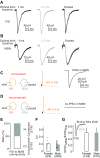Nucleus accumbens feedforward inhibition circuit promotes cocaine self-administration
- PMID: 28973852
- PMCID: PMC5642706
- DOI: 10.1073/pnas.1707822114
Nucleus accumbens feedforward inhibition circuit promotes cocaine self-administration
Abstract
The basolateral amygdala (BLA) sends excitatory projections to the nucleus accumbens (NAc) and regulates motivated behaviors partially by activating NAc medium spiny neurons (MSNs). Here, we characterized a feedforward inhibition circuit, through which BLA-evoked activation of NAc shell (NAcSh) MSNs was fine-tuned by GABAergic monosynaptic innervation from adjacent fast-spiking interneurons (FSIs). Specifically, BLA-to-NAcSh projections predominantly innervated NAcSh FSIs compared with MSNs and triggered action potentials in FSIs preceding BLA-mediated activation of MSNs. Due to these anatomical and temporal properties, activation of the BLA-to-NAcSh projection resulted in a rapid FSI-mediated inhibition of MSNs, timing-contingently dictating BLA-evoked activation of MSNs. Cocaine self-administration selectively and persistently up-regulated the presynaptic release probability of BLA-to-FSI synapses, entailing enhanced FSI-mediated feedforward inhibition of MSNs upon BLA activation. Experimentally enhancing the BLA-to-FSI transmission in vivo expedited the acquisition of cocaine self-administration. These results reveal a previously unidentified role of an FSI-embedded circuit in regulating NAc-based drug seeking and taking.
Keywords: basolateral amygdala; cocaine addiction; fast-spiking interneuron; medium spiny neuron; synaptic plasticity.
Conflict of interest statement
The authors declare no conflict of interest.
Figures







Similar articles
-
A Feedforward Inhibitory Circuit Mediated by CB1-Expressing Fast-Spiking Interneurons in the Nucleus Accumbens.Neuropsychopharmacology. 2017 Apr;42(5):1146-1156. doi: 10.1038/npp.2016.275. Epub 2016 Dec 8. Neuropsychopharmacology. 2017. PMID: 27929113 Free PMC article.
-
Hippocampal-Evoked Feedforward Inhibition in the Nucleus Accumbens.J Neurosci. 2018 Oct 17;38(42):9091-9104. doi: 10.1523/JNEUROSCI.1971-18.2018. Epub 2018 Sep 5. J Neurosci. 2018. PMID: 30185462 Free PMC article.
-
Cell-Type- and Endocannabinoid-Specific Synapse Connectivity in the Adult Nucleus Accumbens Core.J Neurosci. 2020 Jan 29;40(5):1028-1041. doi: 10.1523/JNEUROSCI.1100-19.2019. Epub 2019 Dec 12. J Neurosci. 2020. PMID: 31831522 Free PMC article.
-
Cocaine-induced projection-specific and cell type-specific adaptations in the nucleus accumbens.Mol Psychiatry. 2022 Jan;27(1):669-686. doi: 10.1038/s41380-021-01112-2. Epub 2021 May 7. Mol Psychiatry. 2022. PMID: 33963288 Free PMC article. Review.
-
Nucleus accumbens fast-spiking interneurons in motivational and addictive behaviors.Mol Psychiatry. 2021 Jan;26(1):234-246. doi: 10.1038/s41380-020-0683-y. Epub 2020 Feb 18. Mol Psychiatry. 2021. PMID: 32071384 Free PMC article. Review.
Cited by
-
Noradrenergic Signaling Disengages Feedforward Transmission in the Nucleus Accumbens Shell.J Neurosci. 2021 Apr 28;41(17):3752-3763. doi: 10.1523/JNEUROSCI.2420-20.2021. Epub 2021 Mar 18. J Neurosci. 2021. PMID: 33737458 Free PMC article.
-
An endocannabinoid-regulated basolateral amygdala-nucleus accumbens circuit modulates sociability.J Clin Invest. 2020 Apr 1;130(4):1728-1742. doi: 10.1172/JCI131752. J Clin Invest. 2020. PMID: 31874107 Free PMC article.
-
Effects of Maternal Separation on Effort-based Responding for Sucrose Are Associated with c-Fos Expression in the Nucleus Accumbens Core.Neuroscience. 2024 Jan 26;537:174-188. doi: 10.1016/j.neuroscience.2023.11.030. Epub 2023 Nov 28. Neuroscience. 2024. PMID: 38036058 Free PMC article.
-
Temporal dynamics of nucleus accumbens neurons in male mice during reward seeking.Nat Commun. 2024 Oct 28;15(1):9285. doi: 10.1038/s41467-024-53690-8. Nat Commun. 2024. PMID: 39468146 Free PMC article.
-
Ventral Tegmental Area Projection Regulates Glutamatergic Transmission in Nucleus Accumbens.Sci Rep. 2019 Dec 5;9(1):18451. doi: 10.1038/s41598-019-55007-y. Sci Rep. 2019. PMID: 31804595 Free PMC article.
References
-
- Pennartz CM, Groenewegen HJ, Lopes da Silva FH. The nucleus accumbens as a complex of functionally distinct neuronal ensembles: An integration of behavioural, electrophysiological and anatomical data. Prog Neurobiol. 1994;42:719–761. - PubMed
Publication types
MeSH terms
Substances
Grants and funding
LinkOut - more resources
Full Text Sources
Other Literature Sources

